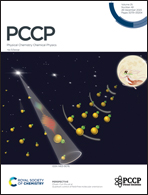Emergence of selectivity and specificity in a coarse-grained model of the nuclear pore complex with sequence-agnostic FG-Nups†
Abstract
The role of hydrophobicity of phenylalanine-glycine nucleoporins (FG-Nups) in determining the transport of receptor-bound cargo across the nuclear pore complex (NPC) is investigated using Langevin dynamics simulations. A coarse-grained, minimal model of the NPC, comprising a cylindrical pore and hydrophobic–hydrophilic random copolymers for FG-Nups was employed. Karyopherin-bound receptor-cargo complexes (Kaps) were modeled as rigid, coarse-grained spheres without (inert) and with (patchy) FG-binding hydrophobic domains. With a sequence-agnostic description of FG-Nups and the absence of any anisotropies associated with either NPC or cargo, the model described tracer transport only as a function of FG-Nup hydrophobicity, f. The simulations showed the emergence of two important features of cargo transport, namely, NPC selectivity and specificity. NPC selectivity to patchy tracers emerged due to hydrophobic Kap–FG interactions and despite the sequence-agnostic description of FG-Nups. Furthermore, NPC selectivity was observed only in a specific range of FG-hydrophobic fraction, 0.05 ≤ f ≤ 0.20, resulting in specificity of NPC transport with respect to f. Significantly, this range corresponded to the number fraction of FG-repeats observed in both S. cerevisiae and H. sapiens NPCs. This established the central role of the FG-hydrophobic fraction in determining NPC transport, and provided a biophysical basis for conservation of the FG-Nup hydrophobic fraction across evolutionarily distant NPCs. Specificity in NPC transport emerged from the formation of a hydrogel-like network inside the pore with a characteristic mesh size dependent on f. This network rejected cargo for f > 0.2 based on size exclusion, which resulted in enhanced translocation probability for 0.05 ≤ f ≤ 0.20. Extended brush configurations outside the pore resulted in entropic repulsion and exclusion of inert cargo in this range. Thus, our minimal NPC model exhibited a hybrid cargo translocation mechanism, with aspects of both virtual gate and selective-phase models, in this range of FG-hydrophobic fraction.



 Please wait while we load your content...
Please wait while we load your content...